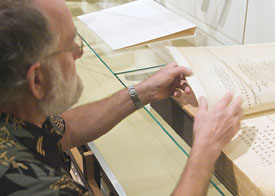To prepare an exhibit space that presents U-M Library’s treasures to the public, it takes precautions and planning to safeguard their integrity while maximizing visual appeal.
For starters, it’s not just any glass encasing books and documents held by the university that in some cases are nearly 2,000 years old.

“It’s a special glass that can filter the UV rays of light coming in, to preserve the documents against aging,” says Peggy Daub, director of the Special Collections Library.
University Library staff last Wednesday celebrated the dedication of the new Audubon Room, adjacent to the first floor Harlan Hatcher Graduate Library Gallery.
The former cataloging area began conversion to an exhibit space this spring. Walls were altered to accommodate cases, existing plaster was patched and repainted, ceiling tiles were replaced, and new trim installed to define and unify the space.
“The oak trim on the windows and doors was stained to match the old existing trim in the Hatcher Gallery. The match is so good that the new room looks like it was always there,” says Shannon Zachary, head of preservation and conservation at University Library.
Once glass display cases were installed, fans ventilated opened cases for six weeks to flush out residual gases from construction. “We used a filter vacuum to remove construction dust and mixed up our own glass-cleaning recipe of ethanol and water so as not to use ammonia-based cleaning products inside the cases,” Zachary says.
The room takes its name from the 3-by-5-foot book “The Birds of America,” published in 1838 with original drawings by John Audubon. This was the first book authorized by the Board of Regents for purchase ($970) for the new university. It is prominently presented near the entrance to the exhibit space.
“The conservation team had to do some repairs, do things such as cleaning the title page of the Audubon book, remove old adhesive and complete other repairs when possible,” says Karen Jordan, exhibits and outreach librarian. Daub said fingerprints and grime along the edges of an opening page of the book, depicting a turkey, were not removed to celebrate the attention the book has drawn.
Conservators Tom Hogarth, Cathy Baker and Leyla Lau-Lamb constructed mats, cradles and supports specifically for the items displayed. Special collections librarians designed the layout of the exhibit and wrote labels.
Zachary says a three-month rotation for displays is necessary to protect the objects from excess exposure to light. Those displays include the eight volumes of the Audubon book. “The pages are turned each week and different volumes substituted into the case so no one plate is put at risk for light damage — and you get to see something new each time you visit,” she says.
The display cases have built-in cavities for packs of silica gel to balance humidity, as the ideal for most books and paper is around 35-50 percent relative humidity. The cases are equipped with a sophisticated alarm system.
University Library curators say the impetus for the new exhibit space came from Paul Courant, university librarian and dean of libraries, as he has encouraged the public presentation of more of the university’s historical holdings — many of which otherwise are in storage.
Among key documents in the collection are Abraham Ortelia’s first atlas presenting a detailed map of the Americas from 1570; a copy of the Letters of Paul to the Early Churches, likely written in 150-250 C.E.; a 1609 letter from Galileo in which he reveals the first evidence of bodies (the moons of Jupiter) orbiting a body other than Earth; and a first edition of Walt Whitman’s “Leaves of Grass” from 1855 that the author presented to Ralph Waldo Emerson.
The exhibit is open from 8:30 a.m.-7 p.m. Monday through Friday, from 10 a.m.-6 p.m. Saturdays and 1-7 p.m. Sundays.
The Audubon Room was funded by Stephen Clark, Jennifer Poteat, Dr. Bernard Sivak and many Friends of the University of Michigan Library.

